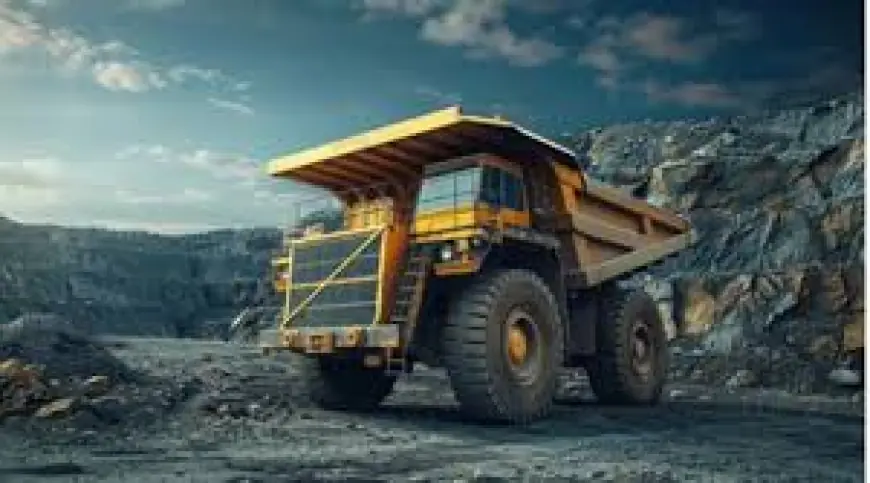Global Electric Off-Highway Equipment Market 2030 Report
Governments worldwide are enforcing stricter environmental regulations to reduce emissions and enhance sustainability in various industries.

The global electric off-highway equipment market is undergoing a transformative evolution, driven by the convergence of sustainability goals, regulatory pressure, and advancements in electric mobility. Valued at USD 18.0 billion in 2024, the market is projected to soar to USD 35.3 billion by 2030, growing at a robust CAGR of 11.53%. This impressive growth highlights a paradigm shift in industries such as construction, mining, and agriculture—sectors traditionally reliant on fossil-fuel-powered heavy equipment.
As these industries prioritize environmental stewardship and operational efficiency, electric off-highway machinery is emerging as a cornerstone of the transition to cleaner industrial practices. From loaders and excavators to dump trucks and graders, electrification is reshaping the heavy-duty machinery landscape.
Emerging Trends in Electric Off-Highway Equipment Market
The market is witnessing a dynamic influx of trends that are not only reshaping product development but also redefining how operations are executed on construction sites, farms, and mining fields.
1. Rise of Autonomous and Smart Electric Machinery
Autonomous electric off-highway equipment is increasingly gaining traction. With integrated AI, IoT sensors, and machine learning capabilities, these machines enhance productivity by reducing human intervention and improving precision. Self-driving electric excavators and autonomous dozers are now being piloted in controlled environments, showing significant potential in reducing labor costs while maximizing safety and uptime.
2. Hybrid Electric Solutions
Although full battery electric solutions are gaining popularity, hybrid electric equipment—combining traditional diesel with electric propulsion—is carving a niche for itself. Hybrid machines offer enhanced operational flexibility, especially in environments where charging infrastructure is limited. These solutions serve as a bridge between conventional and fully electric equipment.
3. Advancements in Battery and Charging Infrastructure
Modern electric off-highway equipment is powered by next-generation lithium-ion batteries with extended life cycles, faster charging capabilities, and improved energy density. Modular battery swapping systems are also being explored for equipment that cannot afford downtime. Simultaneously, mobile charging units and solar-powered charging stations are being tested across remote job sites.
4. Eco-Friendly and Noise-Free Operations
Electric equipment is significantly quieter than traditional diesel machinery, making it ideal for urban construction and residential projects. The reduced noise levels help comply with city ordinances and create a more comfortable working environment. In addition, reduced vibration in electric motors enhances operator comfort and machinery life.
5. Circular Economy and Battery Recycling Initiatives
Manufacturers and governments are launching programs focused on battery recycling and second-life applications. This not only mitigates the environmental impact of used batteries but also supports the circular economy model—further strengthening the green value proposition of electric machinery.
Download Free Sample Report: https://www.techsciresearch.com/sample-report.aspx?cid=27495
Market Drivers Fueling the Growth of Electric Off-Highway Equipment
A multitude of drivers are propelling the adoption of electric off-highway equipment, both at the global and regional levels.
1. Stringent Environmental Regulations
Governments across the globe are enforcing regulations to reduce greenhouse gas emissions and promote cleaner technologies. Regulations such as Euro Stage V and Tier 4 emission standards are pushing manufacturers and operators to shift toward electric alternatives.
2. Corporate Sustainability Goals
Large construction and mining corporations are aligning their operations with ESG (Environmental, Social, and Governance) principles. This involves transitioning their machinery fleets to electric power to meet carbon-neutral targets and enhance their brand value among stakeholders.
3. Operational Cost Savings
Electric machines significantly reduce fuel and maintenance costs. The absence of complex mechanical systems—such as transmissions, fuel injectors, and cooling systems—translates to lower wear and tear, thus reducing downtime and service expenses.
4. Government Incentives and Funding Programs
Various countries are offering financial incentives, subsidies, and tax credits to encourage the adoption of electric heavy equipment. These benefits reduce the initial acquisition cost for businesses and boost ROI on green investments.
5. Improved Energy Efficiency and Performance
Electric motors provide instant torque, superior throttle control, and smoother operation compared to diesel engines. These attributes enhance performance, especially in tasks that require frequent start-stop movements, such as excavation or material hauling.
Industry Key Highlights
- Market Valuation: The global market for electric off-highway equipment reached USD 18.0 billion in 2024 and is projected to hit USD 35.3 billion by 2030.
- Growth Rate: Forecasted CAGR of 11.53% during 2024–2030.
- Leading Segments: Loaders and excavators are the dominant equipment types, with battery electric vehicles (BEVs) leading the propulsion type category.
- Fastest Growing Region: Asia-Pacific is emerging as the most promising region, driven by industrial growth and government support.
- Top Applications: Construction remains the largest application segment, followed by mining and agriculture.
- Propulsion Mix: Battery electric equipment leads, with hybrid electric gaining momentum and fuel-cell variants in early-stage development.
- Key Innovations: Smart telemetry systems, modular battery packs, and autonomous navigation software.
Market Segmentation and Equipment Insights
By Equipment Type
- Loaders: Known for their versatility in loading and material handling, electric loaders offer reduced emissions, lower fuel costs, and improved operator comfort. These machines are ideal for construction and waste management sectors.
- Excavators: Electric excavators are in high demand for urban projects. They provide efficient digging power with minimal noise and zero exhaust emissions, which is crucial in sensitive zones.
- Dozers: Used for grading and earthmoving, electric dozers are being enhanced to withstand harsh terrains. Their energy-efficient operation helps reduce long-term costs.
- Articulated Dump Trucks: Suitable for transporting bulk materials, these trucks are being electrified to improve fuel economy and reduce site emissions in mining and quarrying operations.
- Graders: Graders powered by electric motors provide enhanced grading accuracy with reduced operating noise, making them ideal for roadworks and infrastructure development.
Regional Landscape: Asia-Pacific Takes the Lead
The Asia-Pacific region is expected to witness the fastest growth during the forecast period. Rapid urbanization, expanding infrastructure projects, and environmental regulations are major growth catalysts.
Key Regional Factors:
- China is aggressively pushing for electrification across all machinery sectors with state-driven mandates.
- India is offering policy incentives under programs like FAME (Faster Adoption and Manufacturing of Hybrid and Electric Vehicles).
- Japan and South Korea are investing in battery innovation and hydrogen-powered machinery for future deployment.
These nations are also investing in charging infrastructure and power grid upgrades to accommodate the increasing energy demand from electrified industrial equipment.
Competitive Analysis
The global electric off-highway equipment market is moderately consolidated, with leading players driving innovation and strategic collaborations.
Major Players:
- Hitachi Construction Machinery Co., Ltd. – Known for high-performance electric excavators and loaders with smart diagnostics.
- Volvo CE – A pioneer in electric compact equipment and a leader in telematics integration.
- Caterpillar Inc. – Investing in hybrid models and autonomous electric equipment tailored for mining operations.
- Komatsu Ltd. – Offers a wide range of battery-powered and hybrid construction equipment.
- Liebherr International AG – Focuses on high-capacity electric equipment suitable for harsh environments.
- CNH Industrial N.V. – Developing sustainable electric solutions for agricultural and construction machinery.
- BEML Limited and SANY Heavy Industry are emerging players, especially in Asia, contributing significantly to the regional supply.
These companies are leveraging digital platforms, partnerships, and R&D to gain a competitive edge in the evolving electric machinery landscape.
Future Outlook
The future of the electric off-highway equipment market looks promising, supported by technological innovations, evolving business models, and the global push for sustainability.
What to Expect by 2030:
- Electrification of All Equipment Segments: Full-scale electrification of even the heaviest off-highway machines is expected as battery capabilities evolve.
- Standardized Charging Infrastructure: The industry will likely adopt interoperable charging solutions to enable cross-brand compatibility on worksites.
- AI and Automation Integration: Expect smarter electric machines with autonomous decision-making, real-time diagnostics, and remote control features.
- Decentralized Energy Systems: Job sites will increasingly use renewable energy microgrids to power electric machinery sustainably.
- Rise of Rental Electric Equipment: Shared economy models will boost the rental of electric construction and mining equipment, making them more accessible to SMEs.
10 Benefits of the Research Report
- Detailed Market Forecast till 2030 for strategic planning.
- Comprehensive Segmentation by equipment type, application, and propulsion.
- In-depth Regional Analysis highlighting key growth markets.
- Identification of Key Trends shaping the future of the industry.
- SWOT Analysis of major industry players.
- Policy and Regulatory Insights affecting market dynamics.
- Opportunity Mapping for emerging and mature markets.
- Investment Feasibility Assessment for new entrants.
- Competitive Landscape Review with market share data.
- Actionable Insights for OEMs, investors, and policymakers.
Conclusion
The electric off-highway equipment market is no longer a niche opportunity—it’s a strategic imperative for industries focused on decarbonization, efficiency, and technological modernization. With the dual pressures of environmental responsibility and rising fuel costs, electric machinery is rapidly transitioning from an experimental concept to an operational reality.
As battery technology matures, infrastructure develops, and industry mindsets shift, the global electric off-highway equipment market is poised for substantial, sustained growth. Businesses that adapt early to this transformation will not only gain operational advantages but also secure a leadership position in a future where sustainability and performance go hand in hand.
Contact Us-
Mr. Ken Mathews
708 Third Avenue,
Manhattan, NY,
New York – 10017
Tel: +1-646-360-1656
Email: [email protected]
Website: www.techsciresearch.com
What's Your Reaction?
 Like
0
Like
0
 Dislike
0
Dislike
0
 Love
0
Love
0
 Funny
0
Funny
0
 Angry
0
Angry
0
 Sad
0
Sad
0
 Wow
0
Wow
0

















































